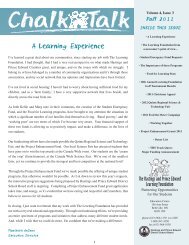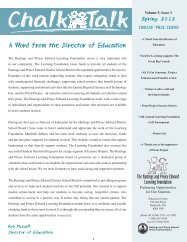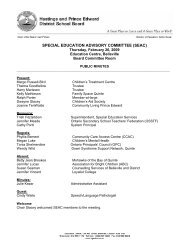Grade 11 Healthy Active Living Education Additional Supports ...
Grade 11 Healthy Active Living Education Additional Supports ...
Grade 11 Healthy Active Living Education Additional Supports ...
You also want an ePaper? Increase the reach of your titles
YUMPU automatically turns print PDFs into web optimized ePapers that Google loves.
Positive Mental Health and Stress<br />
Public Profile<br />
Unit #3 Activity #4<br />
Teaching Learning Strategy #4<br />
Teacher Resource (Background Information)<br />
Catholic Profile<br />
Unit #5 Activity #2. #6<br />
Teaching Learning Strategy #3, #5<br />
Instructions:<br />
1. Provide an introductory exercise by starting with Student Resource- (Worksheet)<br />
ÒGuess These Simple PhobiasÓ. Have students complete the worksheet individually<br />
and then partner up with one other person to compare their thoughts. Take up the<br />
correct answers with the class.<br />
Consider the following discussion questions to broaden studentsÕ perspective on<br />
phobias.<br />
• How might any one of these phobias affect a personÕs daily life?<br />
• What impacts might one of these phobias have on a personÕs physical and/or<br />
emotional well-being?<br />
Ensure students understand that similar to the long list of phobias, mental health<br />
disorders are also many in number and come in varying degrees of severity. Most of<br />
us at some point in our lives will experience a mental health disorder either personally<br />
or with a family member or a friend.<br />
2. As an additional (or alternative) introductory exercise, use Student Resource<br />
(Worksheet) ÒMyth or FactÓ. Have students complete the worksheet individually and<br />
then partner up with one other person to compare their thoughts. Take up the correct<br />
answers with the class.<br />
Consider the following discussion questions to broaden studentsÕ perspective on<br />
phobias<br />
• Did any of the facts/answers surprise you?<br />
• Imagine someone in your family has a mental disorderÉ.How might this affect<br />
your life?<br />
Ensure students understand that just like the rest of us, people with mental illness live<br />
ordinary lives, they have families, jobs, bills to pay, talents, successes and<br />
accomplishments as well as challenges and so on. Use the Teacher Resource<br />
(Overhead) Famous People to emphasize the point. Ask the class: ÒWhat do the<br />
people on this list have in common?Ó Answer: ÒThis is a list of famous people who<br />
have experienced mental illness. Each person has a diagnosis or believed diagnosis of<br />
a mood disorder.Ó Briefly discuss the accomplishments of each and in summary,<br />
communicate clearly to students that mental illness was not a barrier to<br />
accomplishment and success.<br />
3. Divide the students into several groups and assign each group one of the mental<br />
disorders listed below. Each group will research the disorder using the Student<br />
<strong>Grade</strong> <strong>11</strong> <strong>Healthy</strong> <strong>Active</strong> <strong>Living</strong> <strong>Education</strong> (PPL30), Module #2 Positive Mental Health and Stress<br />
Page 57
















